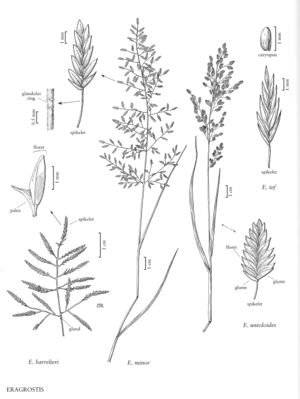Eragrostis unioloides
Plants annual; tufted, without innovations, without glands. Culms 10-50 cm, erect, glabrous below the nodes. Leaves mostly basal; sheaths mostly glabrous, apices pilose, hairs 0.4-3 mm; ligules 0.1-0.2 mm, ciliate; blades (1.8) 5-12 cm long, 2-6 mm wide, flat to involute, abaxial surfaces glabrous, adaxial surfaces scabridulous and glabrous or sparsely hairy, hairs appressed. Panicles 6-15 cm long, 0.5-7 cm wide, ovate, open to contracted; primary branches 0.2-5 cm, appressed or diverging up to 70° from the rachises, glabrous; pulvini glabrous; pedicels 2-8 mm, glabrous. Spikelets 4-8 (10) mm long, (1.6) 2-4 mm wide, ovatelanceolate, loosely imbricate, straw-colored to purplish, with 12-42 florets; disarticulation acropetal, paleas not persistent, rachillas persistent. Glumes ovatelanceolate to lanceolate, hyaline to membranous; lower glumes 1-1.8 mm; upper glumes 1-2.2 mm; lemmas 1.5-1.9 mm, broadly ovate, membranous, lateral-veins raised, apices obtuse to acute; paleas 1.4-1.9 mm, hyaline, keels scabridulous, apices acute to obtuse; anthers 2, 0.2-0.4 mm, purplish. Caryopses 0.6-0.9 mm, ellipsoid, laterally compressed, not grooved, smooth, light-brown. 2n = 20, ca. 30.
Distribution
Md., Pacific Islands (Hawaii), Fla., Ga.
Discussion
Eragrostis unioloides is an Asian species that is now established in the southeastern United States, growing along roadsides and in disturbed ground, at 20-150 m.
Selected References
None.
Lower Taxa
"decumbent" is not a number.
